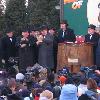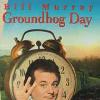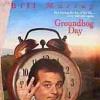

Tags: Groundhog Day View |
Tags: Groundhog Day View |
Tags: Groundhog Day, Groundhog S Day View |
|||||||||
Groundhog Day is a holiday celebrated on February 2 in the United States and Canada. According to folklore, if it is cloudy when a groundhog emerges from its burrow on this day, it will leave the burrow, signifying that winter will soon end. If on the other hand, it is sunny, the groundhog will supposedly retreat into its burrow, and winter will continue for six more weeks. The holiday, which began as a Pennsylvania German (Pennsylvania Dutch) custom in southeastern and central Pennsylvania in the 18th (18th century) and 19th centuries (19th century), has its origins in ancient European weather lore, wherein a badger or sacred bear is the prognosticator as opposed to a groundhog. The holiday also bears some similarities to the medieval (Middle Ages) Catholic holiday of Candlemas (Presentation of Jesus at the Temple). It also bears similarities to the Pagan (Paganism) festival of Imbolc, the seasonal turning point of the Celtic calendar, which is celebrated on February 1 and also involves weather prognostication.
Modern customs of the holiday involve celebrations where early morning festivals are held to watch the groundhog emerging from its burrow. In southeastern Pennsylvania, Groundhog Lodges (Grundsow Lodges) celebrate the holiday with fersommlinge, social events in which food is served, speeches are made, and one or more gspiel (plays or skits) are performed for entertainment. The Pennsylvania German dialect (Pennsylvania German language) is the only language spoken at the event, and those who speak English (English language) pay a penalty, usually in the form of a nickel (Nickel (United States coin)), dime (Dime (United States coin)) or quarter (Quarter (United States coin)), per word spoken, put into a bowl in the center of the table.
The largest Groundhog Day celebration is held in Punxsutawney (Punxsutawney, Pennsylvania), Pennsylvania, where crowds as large as 40,000 have gathered to celebrate the holiday since at least 1886. Other celebrations of note in Pennsylvania take place in Quarryville (Quarryville, Pennsylvania) in Lancaster County (Lancaster County, Pennsylvania), the Anthracite Region of Schuylkill County (Schuylkill County, Pennsylvania), the Sinnamahoning Valley and Bucks County (Bucks County, Pennsylvania). Outside of Pennsylvania, notable celebrations occur in the Frederick (Frederick, Maryland) and Hagerstown (Hagerstown, Maryland) areas of Maryland, the Shenandoah Valley of Virginia, Woodstock, Illinois,, Lilburn, Georgia (Lilburn, GA) and among the Amish populations of over twenty states and at Wiarton, Ontario and Shubenacadie, Nova Scotia in Canada. The University of Dallas in Irving, Texas has taken Groundhog Day as its official university holiday and organizes a large-scale celebration every year in honor of the Groundhog.
Groundhog Day received worldwide attention as a result of the 1993 film of the same name, Groundhog Day (Groundhog Day (film)), which was set in Punxsutawney and featured Punxsutawney Phil.
Holiday Name: Groundhog Day
Observed By: United States and Canada
Celebrations: Observing a groundhog emerging from its burrow and seeing whether it sees its shadow, announcing the result
Type: Cultural
Significance: Whether the groundhog sees its shadow determines how much longer winter will last



